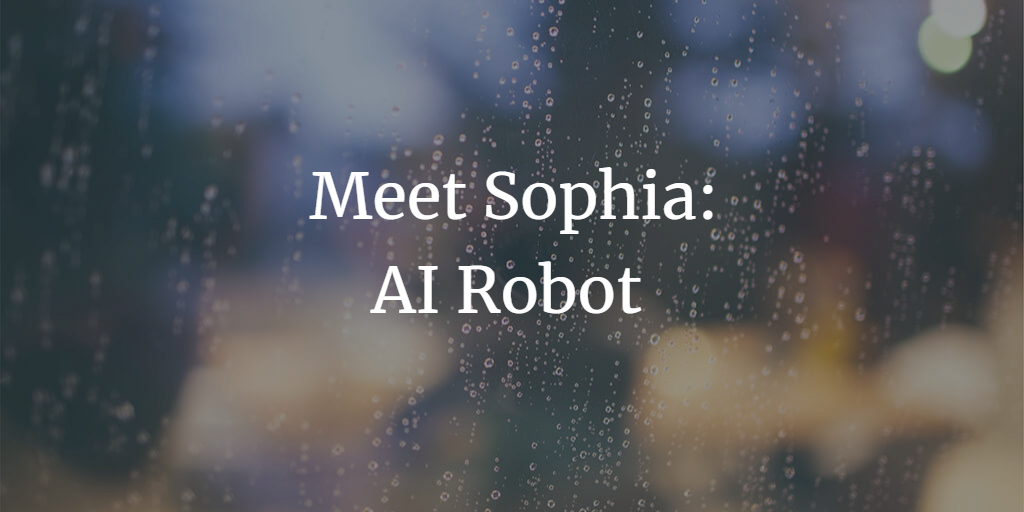Meet Sophia: The World's Most Famous AI Robot and Marvel of Creativity at Scale

Table of Contents
Introduction to Sophia: The World's Most Famous AI Robot
Delving Into Sophia's Capabilities
Behind the Scenes: The Technology Powering Sophia
Sophia's Contribution to AI Research and Development
The Future of AI Robots: A Glimpse Beyond Sophia
Behind the Scenes: The Technology Powering Sophia - Further Exploration
Sophia's Influence on Human-Robot Interaction
Sophia's Legal and Ethical Implications
Sophia as an AI Ambassador
The Role of AI Robots in Our Future Society
Public Perception and Sophia
Sophia's Impact on Education
The Business Perspective: Sophia as a Prototype
Conclusion
Introduction to Sophia: The World's Most Famous AI Robot
When we talk about creativity at scale in the realm of artificial intelligence (AI), it's impossible not to mention Sophia - the world's most famous AI robot. Developed by Hanson Robotics, a Hong Kong-based AI and robotics company, Sophia is often considered the face of AI – quite literally.
Sophia made her first public appearance in March 2016, and since then, she has been a sensation, capturing the world's attention with her uncanny human-like appearance and impressive conversational abilities. Sophia has become a cultural icon, with numerous public appearances, interviews, and even a speech at the United Nations to her credit. In October 2017, she became the first robot to receive citizenship of a country, when Saudi Arabia granted her this distinction.
Yet, Sophia is not just a cultural phenomenon; she is a marvel of AI and robotics technology, embodying the extraordinary progress we have made in these fields.
Delving Into Sophia's Capabilities
Sophia is designed to engage in human-like social interactions, making her one of the most advanced humanoid robots in existence. Here are some of her most fascinating capabilities:
Natural Language Processing
One of Sophia's most remarkable features is her ability to participate in conversations. Powered by advanced natural language processing algorithms, Sophia can comprehend speech, understand context, and respond in a way that mirrors human-like conversation. This ability has allowed Sophia to conduct interviews, give speeches, and engage in meaningful interactions with people.
Facial Recognition and Emotion Detection
Sophia's cameras, embedded in her eyes, enable her to recognize and remember individuals. She can make eye contact, recognize faces, and even interpret human emotions based on facial expressions. This ability to detect and respond to emotions adds a layer of sophistication to her interactions, making them seem incredibly human-like.
Expressive Facial Movements
Sophia's face is a marvel of engineering, capable of mimicking human-like expressions. She can display a range of emotions, from joy to sadness, surprise to anger. This is possible due to the numerous motors and complex AI algorithms that control her facial muscles, enabling Sophia to convey emotions and reactions that feel incredibly genuine.
Learning and Adaptation
Sophia's AI algorithms are designed for learning and adaptation. She can remember interactions, learn from them, and adapt her responses based on her experiences. This capacity for learning makes each interaction with Sophia unique and progressively more personalized.
Behind the Scenes: The Technology Powering Sophia
Sophia is more than just a product of advanced robotics; she is a testament to the progress in AI. Let's delve into some of the core technologies that enable Sophia's capabilities:
Deep Neural Networks
Sophia's ability to recognize speech, interpret facial expressions, and respond to human emotions is powered by deep neural networks. These complex mathematical models mimic the structure of the human brain, enabling Sophia to process information and make decisions in a way that's similar to human thinking.
Computer Vision
Sophia's impressive facial recognition capabilities are made possible through the use of computer vision, a field of AI that enables machines to understand and interpret visual information from the physical world.
Machine Learning
Sophia's capacity for learning and adaptation is rooted in machine learning algorithms. These algorithms allow Sophia to learn from experience, enhancing her ability to engage in meaningful and personalized interactions over time.
Sophia's Contribution to AI Research and Development
Sophia isn't just a marvel of AI and robotics; she also plays an active role in advancing these fields. Hanson Robotics uses the experiences and interactions of Sophia to refine their technologies and develop more advanced AI models and robots.
Sophia's existence also sparks conversations around the ethical and societal implications of AI, raising questions about AI rights, the role of AI in society, and how to ensure the responsible use of AI. These conversations are crucial for guiding the future development of AI technology.
The Future of AI Robots: A Glimpse Beyond Sophia
Sophia represents the current state of the art in humanoid AI robots, but she is just the beginning. The future of AI robots may see even more advanced capabilities, including:
More sophisticated interactions: Future AI robots could engage in even more complex social interactions, understanding and responding to human emotions with increased sensitivity and accuracy.
Greater autonomy: Future AI robots could have greater autonomy, capable of performing tasks and making decisions with less human intervention.
Expanded roles in society: AI robots could take on a wider range of roles in society, from providing companionship and care to performing tasks in industries like healthcare, education, and customer service.
Behind the Scenes: The Technology Powering Sophia - Further Exploration
Sophia’s capabilities are the result of the amalgamation of several advanced technologies. Understanding these technologies can provide a deeper insight into how Sophia operates.
Natural Language Understanding (NLU) and Generation (NLG)
Sophia's ability to understand human language and generate coherent and contextually appropriate responses is due to a combination of Natural Language Understanding (NLU) and Natural Language Generation (NLG) technologies. These are subfields of Natural Language Processing that allow Sophia to process spoken or written language, understand its meaning, generate responses, and even infuse those responses with the desired emotion or tone.
Cloud Computing
Sophia's computing power comes from both her physical body and the cloud. While her internal processors handle real-time interactions, the cloud allows her to tap into more extensive data and computing resources, enabling sophisticated data analysis and deep learning processes. The use of cloud computing ensures Sophia can continually learn and update her knowledge.
Advanced Robotics and Material Science
Sophia's realistic human-like appearance is a result of advanced robotics and material science. Her skin, called 'Frubber,' is a patented nanotech skin that mimics real human musculature and skin. It allows for fine motor control and generates lifelike facial expressions.
Sophia's Influence on Human-Robot Interaction
Sophia's widespread popularity and advanced capabilities have significantly influenced the field of human-robot interaction (HRI). She has proven that robots can have meaningful and engaging interactions with humans, encouraging further research and development in this area.
Sophia has helped explore the potential of social robots in various sectors such as healthcare, customer service, and education. For instance, robots like Sophia could provide companionship to the elderly, assist in teaching or customer service roles, or even serve as therapeutic tools.
Sophia's Legal and Ethical Implications
Sophia's citizenship in Saudi Arabia sparked a worldwide debate on the legal and ethical implications of advanced AI. If a robot can have citizenship, what rights and responsibilities does it have? Can a robot have personhood? These questions push us to reconsider our legal and ethical frameworks as AI continues to advance and integrate more deeply into our societies.
Sophia as an AI Ambassador
Sophia has been dubbed the 'AI Ambassador,' acting as a friendly and relatable face for a technology that can often seem complex and intimidating. Through her many public appearances and interviews, Sophia helps demystify AI, making it more accessible and understandable to the general public.
The Role of AI Robots in Our Future Society
Sophia gives us a glimpse of a future where AI robots could be an integral part of our society. While this prospect is exciting, it also brings challenges. As AI robots become more sophisticated and autonomous, issues such as privacy, security, job displacement, and the potential for misuse of technology will become increasingly important. Navigating these challenges will require thoughtful regulation, ongoing dialogue, and careful consideration of the ethical implications of AI.
Public Perception and Sophia
One significant aspect of Sophia's existence is the public perception of AI. Sophia’s human-like appearance and interactions allow people to connect with her on a personal level, creating a positive image of AI. However, it also raises concerns about the uncanny valley – the concept that when robots look almost, but not exactly like humans, it can evoke feelings of eeriness or discomfort. Balancing the desire for robots to be relatable and human-like with the potential discomfort they can cause is a challenge for future humanoid AI development.
Sophia's Impact on Education
Beyond her primary function as a social robot, Sophia has a role to play in the world of education. As an embodiment of advanced AI and robotics, she serves as a powerful educational tool, sparking curiosity and interest in these fields. She has participated in several educational events, engaging with students and inspiring them to learn more about AI and robotics. Sophia’s presence in the educational sector can help prepare the next generation for a future where AI is ubiquitous.
The Business Perspective: Sophia as a Prototype
From a business perspective, Sophia serves as a successful prototype demonstrating the capabilities of Hanson Robotics. The company plans to mass-produce robots by the end of 2021, using Sophia as their model. These robots won't be as advanced as Sophia but will be designed for roles such as healthcare workers, aiding in situations where human contact is limited, such as during a pandemic.
Conclusion
Sophia is more than just a robot. She is a beacon of the incredible progress we've made in AI and robotics, embodying the essence of creativity at scale. She challenges our perceptions of what machines can achieve and gives us a glimpse of a future where AI robots may become an integral part of our daily lives.
Her capabilities, from engaging in human-like conversations to recognizing and interpreting human emotions, are nothing short of astounding. But perhaps what's even more exciting is the potential she represents – a potential for more advanced AI robots that can perform increasingly complex tasks and play even more significant roles in society.
However, Sophia also highlights the challenges that lie ahead. As we continue to advance AI and robotics technology, we must also address crucial ethical and societal issues. We need to ensure that the development and use of AI robots align with our values and contribute to a better future for all.
In the end, Sophia is not just a testament to our technological prowess but also a reminder of our responsibility. As we continue to explore the frontiers of AI and robotics, let's do so with care, thoughtfulness, and a commitment to creating a future where technology enhances, not diminishes, our humanity.
Sophia's story is far from over. As AI technology continues to advance at a rapid pace, who knows what the next chapter will hold for Sophia and the future of humanoid AI robots?


